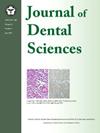牙周韧带成纤维细胞利用异戊烯中间体二磷酸法尼酯维持骨/软骨分化能力
IF 3.4
3区 医学
Q1 DENTISTRY, ORAL SURGERY & MEDICINE
引用次数: 0
摘要
背景/目的过氧化物酶体增殖物激活受体γ (PPARγ)是能量代谢相关基因的主要转录因子,在牙周组织和细胞中已经鉴定出三种PPARγ亚型。当能量代谢稳态受到牙周韧带成纤维细胞(PDLFs)中PPARγ下调的影响时,成骨/骨质形成能力明显丧失。在这里,我们研究了PPARγ激动剂是否促进牙周组织再生,以及哪些PPARγ亚型和代谢途径对骨/骨质形成能力是不可或缺的。材料与方法局部应用PPARγ激动剂再生小鼠牙周组织。使用过表达策略评估pdlf中PPARγ亚型的不同功能。利用ppar γ-敲低PDLFs的基因本体分析来搜索候选代谢过程。体外分化实验评价了两种主要的类异戊二烯中间体法尼基二磷酸(FPP)和香叶基二磷酸(GGPP)的作用。结果spparγ激动剂促进牙周组织再生。全长PPARγ过表达特异性地增强了PPARγ激动剂诱导的pdlf的成骨/骨质分化。类异戊二烯代谢过程是PPARγ敲低后排名第一的下调代谢相关途径;FPP和GGPP分别增强和抑制PDLFs的分化。临床人类牙周组织的基因表达分析显示,骨钙素与催化FPP生成的法尼基焦磷酸合成酶(FDPS)相关,但与两种FPP转化酶:香叶基香叶基二磷酸合成酶1 (GGPS1)或法尼基二磷酸法尼基转移酶1 (FDFT1)无关。结论较好的PPARγ拮抗作用依赖于PPARγ全长亚型。FPP增加了pdlf的成骨/骨质形成能力。因此,使用FPP并精确控制FDPS、GGPS1和FDFT1的活性可能是加速牙周组织再生的新策略。本文章由计算机程序翻译,如有差异,请以英文原文为准。
Periodontal ligament fibroblasts utilize isoprenoid intermediate farnesyl diphosphate for maintaining osteo/cementogenic differentiation abilities
Background/purpose
Peroxisome proliferator-activated receptor γ (PPARγ) is a major transcription factor of energy metabolism-associated genes, and three PPARγ isoforms have been identified in periodontal tissues and cells. When energy metabolism homeostasis is affected by PPARγ downregulation in periodontal ligament fibroblasts (PDLFs), osteo/cementogenic abilities are markedly lost. Herein, we investigated whether PPARγ agonists promote periodontal tissue regeneration, and which PPARγ isoforms and metabolic pathways are indispensable for osteo/cementogenic abilities.
Materials and methods
A PPARγ agonist was locally administered to regenerate murine periodontal tissue. The distinct functions of the PPARγ isoforms in PDLFs were assessed using an overexpression strategy. Candidate metabolic processes were searched using gene ontology analysis of PPARγ-knockdown PDLFs. In vitro differentiation assays were performed to evaluate the effects of farnesyl diphosphate (FPP) and geranylgeranyl diphosphate (GGPP), two major isoprenoid intermediates.
Results
PPARγ agonists accelerated periodontal tissue regeneration. Full-length PPARγ overexpression specifically enhanced the osteo/cementogenic differentiation of PPARγ agonist–induced PDLFs. The isoprenoid metabolic process was the top-ranked downregulated metabolism-associated pathway following PPARγ knockdown; FPP and GGPP enhanced and suppressed PDLFs' differentiation, respectively. Gene expression analysis of human clinical periodontal tissues revealed that osteocalcin correlated with farnesyl pyrophosphate synthetase (FDPS), which catalyzes FPP production, but not with two FPP conversion enzymes: geranylgeranyl diphosphate synthase 1 (GGPS1) or farnesyl diphosphate farnesyltransferase 1 (FDFT1).
Conclusion
Preferable PPARγ agonistic actions depend on the full-length PPARγ isoform. FPP increased PDLFs' osteo/cementogenic abilities. Therefore, administering FPP and precisely controlling FDPS, GGPS1, and FDFT1 activities could be a novel strategy for accelerating periodontal tissue regeneration.
求助全文
通过发布文献求助,成功后即可免费获取论文全文。
去求助
来源期刊

Journal of Dental Sciences
医学-牙科与口腔外科
CiteScore
5.10
自引率
14.30%
发文量
348
审稿时长
6 days
期刊介绍:
he Journal of Dental Sciences (JDS), published quarterly, is the official and open access publication of the Association for Dental Sciences of the Republic of China (ADS-ROC). The precedent journal of the JDS is the Chinese Dental Journal (CDJ) which had already been covered by MEDLINE in 1988. As the CDJ continued to prove its importance in the region, the ADS-ROC decided to move to the international community by publishing an English journal. Hence, the birth of the JDS in 2006. The JDS is indexed in the SCI Expanded since 2008. It is also indexed in Scopus, and EMCare, ScienceDirect, SIIC Data Bases.
The topics covered by the JDS include all fields of basic and clinical dentistry. Some manuscripts focusing on the study of certain endemic diseases such as dental caries and periodontal diseases in particular regions of any country as well as oral pre-cancers, oral cancers, and oral submucous fibrosis related to betel nut chewing habit are also considered for publication. Besides, the JDS also publishes articles about the efficacy of a new treatment modality on oral verrucous hyperplasia or early oral squamous cell carcinoma.
 求助内容:
求助内容: 应助结果提醒方式:
应助结果提醒方式:


